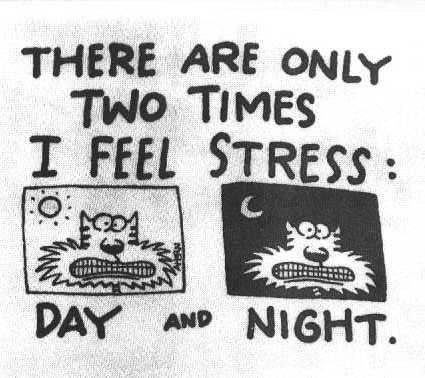What is stress?
 |
| Stress occurs in whole day, not only in working hours. |
According to Stone, Raymond (2008), “Stress has been described as the rate of wear and tear on the body
caused by living. It is a general term for pressures and problems people
experience as they go through life. In itself, stress is neither good nor bad.
In fact, some degree of stress is normal and necessary for day-to-day survival.
Even when people are relaxed there is a minimal amount of stress present.
Without stress, energy, and motivation would be absent. Stress is unavoidable
in human existence.”
“Stressors are the things that cause
stress. They are the stimuli or circumstances that bring about a change in
people’s psychological and physiological equilibrium. Whether the stressors are
positive or negative, the initial physiology reactions are much the same. Rapid
heartbeat, increase blood pressure, dryness in the mouth and quickened
breathing are some of the dominant reactions.” (Stone, 2008)
Type of Stressors
 |
| Stress can killed a person |
The stressor includes work overload and underload, role conflict
and role ambiguity, bad bosses, and workaholism.
Work overload is to describe the common
condition of overwork.
There are two types of work overload:
1. Quantitative overload
2. Qualitative overload.
 |
| It is stress when we cannot handle the job task. |
Quantitative overload is employee having too much of
work to do in the time available. It is an obvious source of stress and linked
to a chronic disease such as coronary heart disease.
Qualitative overload involves the work that is too
difficult. Having inadequately ability to perform a job is stressful. Even
though the employees have a considerable ability, it is also finding them in
some situation which they cannot cope with the job’s demand.
Work underload is the employees having the work
that are too simple or insufficient to fill a worker’s time or challenge an
employee’s abilities. It is also stressful. Work underload will increase
boredom and monotony and reduced job satisfaction.
An employee’s role in the organization can be a source of
stress.
Role ambiguity arises when the scope and
responsibilities of a job are unstructured defined. The employees do not know
what to do and what is expected. Most of the new employees are facing this
problem due to the unclear job description. An adequate orientation programs
for mew employees can reduce the role ambiguity. There are three components of
role ambiguity that found by I-O psychologist: performance criteria ambiguity
which is irresolute about the standards used to evaluate an employee’s job
performance, work method ambiguity which is uncertainty about the procedures
appropriate to the successful performance of the job, and scheduling ambiguity
is the uncertainty about the timing of the job.
Role conflict arises when a discord occurs in
job requirement or between the job’s demands and the values or expectations
between the employees. For example, a supervisor may ask the subordinates to
involve the decision making but the subordinates’ suggestion may not increase
the productivity.
A poor leadership behavior can lead to stress.
For example, supervisors or managers fail to support their
subordinates or refuse their subordinates' decision without any reason
or explanation. When the subordinates cannot get any approves from their
superiors, they feel helpless, hopeless, and useless during the work.
People who are
addicted to their work are descripted as workaholics. Not all the
employees are described as workaholics but it is for those who are anxious and
insecure. Workaholics are happy, well-adjusted people who enjoy their work.
These kinds of people seldom take vacations because they feel it is
unnecessary. But they may become a source of stress to other due to their
extreme sense of commitment.
 |
| For those who are workaholic would not rest for a moment. |
Written by Leow Bee Lian


















0 comments:
Post a Comment